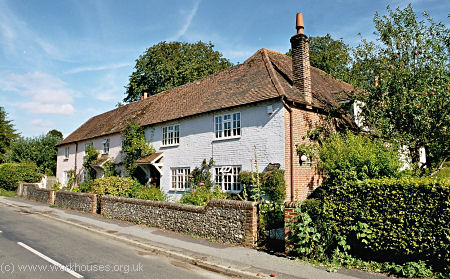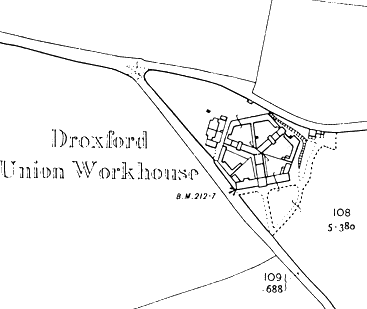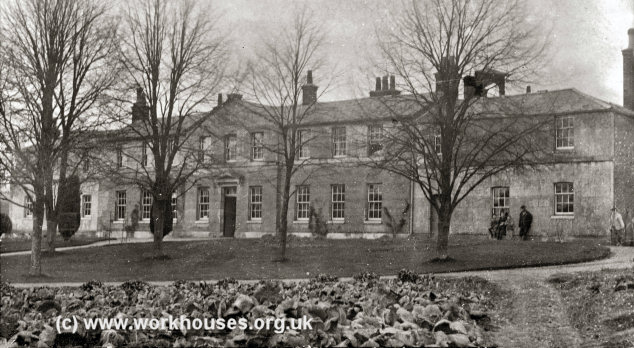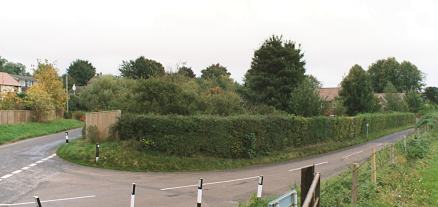Droxford, Hampshire
Up to 1834
A parliamentary report in 1777 recorded a parish workhouse in operation at Bishop's Waltham with accommodation for up to 40 inmates.
A row of four houses on East Street in Hambledon was used as the parish workhouse from around 1720 to 1838. There was also a parish workhouse at Droxford.

Hambledon former parish poorhouse, 2004.
© Peter Higginbotham.
After 1834
Droxford Poor Law Union was formed on 20th March 1835. Its operation was overseen by an elected Board of Guardians, 15 in number, representing its 11 constituent parishes as listed below (figures in brackets indicate numbers of Guardians if more than one):
Hampshire:
Bishop's Waltham (2), Corhampton, Droxford (2), Durley, Exton, Hambledon (2), Meon-Stoke, Soberton, Upham, Warnford, West Meon
Later Additions (all from 1894): Curdridge, Shedfield, Swanmore.
The population falling within the union at the 1831 census had been 9,549 with parishes ranging in size from Corhampton (population 125) to Bishop's Waltham (2,181) and Droxford itself (1,620). The average annual poor-rate expenditure for the period 1831-34 had been £9,717 or £1.0s.4d. per head of the population.
Initially, the union made use of the former parish workhouse premises at Bishop's Waltham while a new building was being erected at Droxford. The Bishop's Waltham establishment soon became embroiled in scandal. In February 1836, a 66-year-old inmate named Honor Shawyer died of "mortification of the bowels". At a subsequent coroner's inquest, accusations of neglect were made against the workhouse master and matron, Edmund and Elizabeth Privett, who it was said had failed to summon a doctor despite being repeatedly asked to do so. Although the coroner recommended that the Privetts be removed from their positions, they remained in post for a further seven weeks, with their eventual discharge due — it was said — to Mrs Privett's drunkenness. John Murphy was appointed as the new master but he, too, had to contend with unwelcome publicity when it was revealed that the inmates were being served "pork-water" instead of soup, and puddings made of the skimmings of pork-water instead of suet. After Murphy had complained about the introduction of the diet, which had been imposed by the Board of Guardians, it was agreed that he should make the soup using half fresh meat and half salt meat. One of the Guardians agreed to visit the workhouse to review the matter but, after he failed to appear, Murphy had reverted to the traditional way of making broth. Soon afterwards, Murphy was dismissed, for reasons which were somewhat unclear. The workhouse chaplain, the Revd Mr Brock, who had sent food from his own house for sick inmates was censured by the Guardians as being meddling and officious. Murphy was succeeded by William Harrison, former master of the Hambledon parish workhouse. Harrison, too, became involved in another workhouse scandal when three young boys being housed temporarily at the neighbouring Fareham union's workhouse were returned after three months showing signs of sickness and neglect — for further details see the separate page on the Fareham union.
A new union workhouse for up to 200 inmates was erected in 1836-7 at a site to the north-west of Droxford. In 1837, the Poor Law Commissioners authorized the sum of £4,452 on its construction, plus a further £1,385 the following year. It was designed by Sampson Kempthorne who was the architect of many early Union workhouses, including those for the Andover, Basingstoke, New Forest and Winchester unions. Droxford workhouse was based on his model hexagonal plan which had a front administrative block, behind which three accommodation wings radiated from a central supervisory hub. The areas between the wings formed segregated exercise yards for the different classes of inmate (old/young, male/female etc.) The workhouse location and layout are shown on the 1909 map below.

Droxford workhouse site, 1909

Droxford workhouse from the south-east, early 1900s.
© Peter Higginbotham.
After 1930, the workhouse became a Public Assistance Institution under the conrol of Hampshire County Council. It subsequently became known as Waltham House and continued in operation after 1948 as an old people's home. A 1953 article in the Hampshire Gazette indicates the state of the buildings at that time:
The workhouse buildings were demolished in around 1986 and the site redeveloped for housing.

Droxford former workhouse site from the west, 2001.
© Peter Higginbotham.
Staff
Inmates
Records
Note: many repositories impose a closure period of up to 100 years for records identifying individuals. Before travelling a long distance, always check that the records you want to consult will be available.
- Hampshire Record Office, Sussex Street, Winchester SO23 8TH. Few records survive — holdings include Guardians' minute books (1835-1930); Ledgers (1836-1928); Letter books (1835-39).
Bibliography
- Higginbotham, Peter The Workhouse Encyclopedia (2014, The History Press)
Links
- None.
Unless otherwise indicated, this page () is copyright Peter Higginbotham. Contents may not be reproduced without permission.


